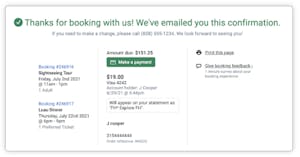- 12 minute read
- Business Management Tips
- Dashboard & FareHarbor
- Industry Insights
Weathering the Storm: Guidelines for Managing Weather-Related Challenges in Outdoor Activities
Beginner,
Intermediate
Join hundreds of other operators and REGISTER NOW for Spark 2024 New Orleans October 13-15th!

No-shows and last-minute cancellations can be extremely frustrating for operators. Not to mention the fact that they can cause a loss of revenue, fewer tips for your employees, unplanned changes in staff schedules, and disgruntled customers.
While no-shows and cancellations may occur because a customer gets lost on their way to your business or simply shows up late, you want to do everything you can to avoid disruptions to your operations.
This guide will provide a few strategies that will discourage customers from skipping out on their tour or activity.
You will always have some no-shows and cancellations as a tour operator. However, the more prep you do on your policies and communication, the less likely they are to cause major disruptions.
We can’t recommend this enough! Instating a strong cancellation policy will help protect your business from upset customers as well as credit card disputes.
Your policy should answer all common customer questions, like what to expect when they cancel, how much money they will get back, and anything else pertinent to your chosen rules.
Note that you don’t HAVE to refund a customer who no-shows. But, if this is the stance you take, be sure to outline this scenario in your policy.
Some companies decide to offer only a portion of the tour cost back depending on when the cancellation happens.
Bottom line, your cancellation policy should strike a balance between protecting your business while still allowing some flexibility for customers.
It’s easy to create and update your cancellation policy in the Dashboard. You can apply this to all of your items or have a different policy for each item.
You should also utilize cancellation notes, which are a written summary of your policy, included in emails sent to your customers.
It is important to communicate the cancellation policy everywhere and often to ensure customers are aware before booking an activity on your website. List the policy on your website FAQ page, tour pages, and in emails — both the booking confirmation and reminder emails.
 Pro Tip: Don’t forget about an inclement weather policy! Having a bad weather policy will further protect your business when you need to cancel in the case of snowstorms, thunderstorms, and any weather events that prevent you from running your activities.
Pro Tip: Don’t forget about an inclement weather policy! Having a bad weather policy will further protect your business when you need to cancel in the case of snowstorms, thunderstorms, and any weather events that prevent you from running your activities.
At the end of the day, your customers want flexibility. Having a policy created with the customer’s needs in mind can improve your customer experience and deter negative online reviews.
A great option to reduce revenue loss with customer cancellations is by offering online rebooking. This feature allows your customers to pick a new date and time to go on your tour completely on their own — which means this feature also saves you and your staff time. 
You can also offer online cancellations. Of course, you don’t want people to cancel, but if they can do it online, it’s a better user experience for them rather than having to call you.
With this feature, you can encourage people to book with your business in the future by offering a gift card to your business in place of a refund. This keeps funds with you and allows the customers to take a future tour. As always, just make sure to communicate this in your cancellation policy.
No matter how excited a customer is to participate in your activity, if they booked it months in advance they might forget or mix up the dates.
To remind customers of their experience, set up canned messages to send via email or text. You can choose to send your communications 24 hours before their availability start time or earlier.
We recommend including all pertinent information in this messaging to ensure your customers are prepared to visit your business.
To learn more about how to craft effective reminder communications, visit this article.
No-shows happen when a customer simply misses the boat. For instance, they arrive late, they get lost on the way to your business or they go to the wrong location.
If you know your location is hard to find, that should be clearly communicated in your confirmation and reminder emails as well as on your website.
If you see an ongoing problem of no-shows or cancellations and it is negatively impacting your business, consider implementing deposits on certain activities. Especially with your more expensive offerings, deposits will encourage customers to show up to their tour or activity as they would lose money otherwise.

 Pro Tip: Our deposits feature works with payment links. The latter allows your customers to easily pay their balance online at a later time. Read this client success story to learn how one of our clients used these two features to start selling their high-end custom photo tours online.
Pro Tip: Our deposits feature works with payment links. The latter allows your customers to easily pay their balance online at a later time. Read this client success story to learn how one of our clients used these two features to start selling their high-end custom photo tours online.
Head to part 2 of this series for details on how to manage no-shows and cancellations when they do happen.